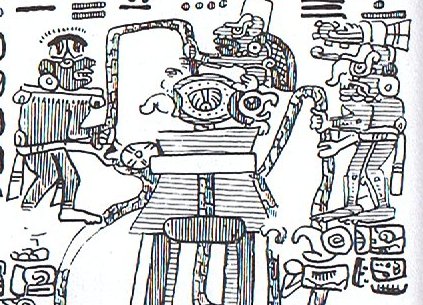4. The spinning top is like the sky dome near the celestial pole, where the 'turtle' has business to do. When sun reaches winter solstice he is as close to the pole as he can come. A new fire is to be lit at the pole, presumably using the friction from the spinning 'roof'. The expression i ni(k)a (above) is close to nikau = the ni tree:
The tree stands in the middle of the 'sea', because winter solstice is located in the middle of the 'watery' part of the year. At the celestial pole not only the 'turtle' but also the 'snake' is at work (maybe it is Rigi?). In the Mayan picture of the activities we can at middle left see how a long winding snake is adorned with a sun sign (kin):
Furthermore, at right bottom it seems as if the snake is cut in two by what looks like a turtle head. It is as if hônu is liquidating the celestial snake at the proper time. |
